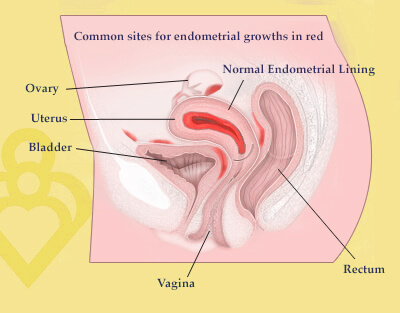Endometriosis is a condition where the lining of the uterus is found outside the uterus
This misplaced tissue may be found on the ovaries, uterus, bowel, bladder utero-sacral ligaments (ligaments that hold the uterus in place), or peritoneum (covering lining of the pelvis and abdominal cavity). On rare occasions it can be found in other distant sites. Endometriosis may also be found during the investigation of infertility.
Endometriosis is typically suspected when pain is felt
- With period
- During ovulation
- In the bowel during menstruation
- When urinating
- During intercourse
- In the lower back
- Diarrhea or constipation
- Heavy bloating
- Fatigue
- “Premenstrual syndrome” (PMS-type symptoms)
- Heavy periods
Endometriosis affects 5-6 million U.S. women, approximately 6-7% of all females, 30-40% of whom are infertile.
 The American Society of Reproductive Medicine (ASRM) has established a grading system to document the degree of severity of the disease. Unfortunately, this has not been particularly helpful in predicting response to therapy. Stage I constitutes a mild form of endometriosis whereas Stage IV is the most severe form.
The American Society of Reproductive Medicine (ASRM) has established a grading system to document the degree of severity of the disease. Unfortunately, this has not been particularly helpful in predicting response to therapy. Stage I constitutes a mild form of endometriosis whereas Stage IV is the most severe form.
The cause of endometriosis is unknown, but there are a number of theories.
One theory is that the endometrial cells loosened during menstruation may “back up” through the fallopian tubes into the pelvis. Once there, they implant and grow in the pelvic or abdominal cavities. This is called retrograde menstruation. This happens in many women, but there may be something different about the immune system in women who develop endometriosis compared to those who do not get the condition. Other theories include tissue transplantation, induction of changes in peritoneal lining cells, spread through uterine veins, and direct extension through the lymphatic system. No one theory seems to explain all cases.
Endometriosis is a common problem.
Endometriosis is estimated to affect millions of women worldwide. Sometimes, it may run in the family. Although endometriosis is typically diagnosed between ages 25 – 35, the condition probably begins about the time that regular menstruation begins. A woman who has a mother or sister with endometriosis is six times more likely to develop endometriosis than women in the general population. Other possible risk factors include:
- Starting menstruation at an early age
- Never having had children
- Frequent menstrual cycles
- Periods that last 7 or more days
- Problems such as a closed hyman, which blocks the flow of menstrual blood during the period
A laparoscopy, an outpatient surgical procedure, is necessary to confirm a diagnosis after a medical history review and pelvic exam. After the initial diagnosis, your physician will classify your condition as stage I (minimal), stage II (mild), stage III (moderate) or stage IV (extensive) based on the amount of scarring and diseased tissue found. Based on the stage of endometriosis, your physician will determine the best treatment plan for you that may include medication or surgery, or a combination of both.



